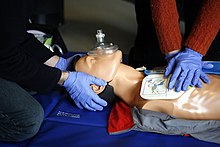Instructional design/Learning objectives/Writing a Well-Formed Learning Objective
| Instructional Design | ID Learning Objectives | < Back | Next > |
Putting It All Together
[edit | edit source]Now that we have reviewed each component of a well-written learning objective, let's review the major questions to ask when formulating each part. The questions we covered under each lesson are compiled here in a "writing learning objectives checklist."
Performance
- Is the performance required a main intent or goal of the instruction?
- Is the performance an observable (overt) action? If the performance not directly observable, is there an action indicator?
- Is the performance measurable?
Conditions
- Have you described what the learner will be given (or not given) during the performance of the objective?
- Have you described the context or environment that will influence the performance?
- Is the condition focused on the learner (and not the instruction)?
Criterion
- Does the criterion specify how well the learner needs to perform in order to appropriately achieve the objective?
- Does the criterion specify when the behavior has been achieved, or the performance is completed?
- Is the performance measured by speed, quality, quantity or accuracy?
- Is this measurement realistic?
Writing Learning Objectives Job Aids
[edit | edit source]Please access or print the following two documents to help with formulating learning objectives. Use them as we look at a few examples of objectives. Answer the questions on the Writing Learning Objectives Checklist.
Writing Learning Objectives Checklist
Learning Objective Example - CPR Scenario
[edit | edit source]According to a recent study on choking fatalities, roughly 14% of all choking incidents occur in restaurants. Of the 19 choking episodes occurring in restaurants, only one employee was documented to attempt a resuscitative effort. The study concluded that though choking is an "infrequent event, victims who choke to death in restaurants appear to lack intervention from restaurant personnel (only one in 19), with no CPR in almost half of the cases until medical help arrived (53% of the interventions came from other patrons).”

You have been chosen to write the learning objectives for a CPR course of instruction for a local restaurant. The resources the class will have are the participants who are taking the course, a rescucitation mannequin, a CPR/First-Aid handbook, and a First Aid / CPR checklist. Since choking and heart attacks are life-threatening situations, the particpants must be able to master the knowledge and skills.
Examples of learning objectives:
- Given a scenario where a customer is choking, the participant must be able to list the symptoms of choking victim with 100% accuracy. (Knowledge)
- During a simulation, the participant must be able to explain how to check the customer's airway with 100% accuracy. (Comprehension)
Write an objective
[edit | edit source](Add an objective here for checking the pulse rate or breathing of a victim. Click the edit button next to the Write an Objective headline and type it below here. After you're done, click the save page button below)
Given a watch that displays seconds and a simulated victim, the learner will be able to check the pulse of the victim. The victim's pulse must be checked within 15 seconds and be within +/- 5% of the reading of an electronic pulse measuring device. Phonebein 20:14, 19 April 2008 (UTC)
given a watch that displays seconds & a simulated victim, the learner will be able to check the pulse rate. Victim's pulse must be checked within 60 seconds and be within +/- 5% of the reading of an accurate electronic pulse measuring devise. 41.78.40.23 06:33, 3 January 2011 (UTC) 41.78.40.23 06:48, 3 January 2011 (UTC)
Navigation
[edit | edit source]Click Next to continue.
| Instructional Design | ID Learning Objectives | < Back | Next > |
